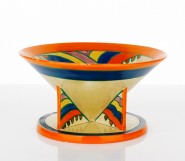Lot #13 - William Strutt
-
Auction House:Deutscher and Hackett
-
Sale Name:Important Australian + International Art
-
Sale Date:10 Apr 2019 ~ 7pm (AEST)
-
Lot #:13
-
Lot Description:William Strutt
(1825 – 1915)
Slack Times, 1883
oil on canvas
79.0 x 92.0 cm
signed lower right: W. Strutt. senr; bears inscription on frame verso: Slack Times by W. Strutt / Exhibited 1884 / … London Society; [including pencil study; 180744B; FIRST SKETCH FROM NATURE, Study for SLACK TIMES, 1883; pencil on paper; 14.0 x 20.5 cm; inscribed with title lower centre: First Sketch from nature] -
Provenance:Private collection; Louise Whitford Galleries, London; Kozminsky Galleries, Melbourne, 1977; Joseph Brown Gallery, Melbourne, September 1982; Private collection, Melbourne; Deutscher~Menzies, Melbourne, 20 April 1998, lot 19; Private collection, United Kingdom
-
Exhibited:William Strutt, Art Gallery of New South Wales, Sydney, February – March 1981, cat. 18 (label attached verso); Joseph Brown Gallery, Melbourne, 1 – 14 September 1982, cat. 13 (illus.)
-
References:Curnow, H., The Life and Art of William Strutt 1825-1915, Martinborough, New Zealand, 1980, cat. 91, pl. 39, p. 160 (illus.); Curnow, H., William Strutt, Australian Gallery Directors Council in conjunction with Art Gallery of New South Wales, Sydney, 1980, cat. 18, p. 73 (illus.)
-
Notes:Among the several towering figures of late colonial art including his friend Eugène von Guérard, William Strutt is best remembered for his grand canvases recording epic events and celebrating heroic figures from the pages of Australian history of which he was such a brilliant witness. Black Thursday, February 6th. 1851, 1864 (La Trobe Collection, State Library of Victoria, Melbourne), the most memorable of his history paintings, presents a dramatic panorama of that fateful day in February 1851 when bushfires engulfed Victoria. Bushrangers, Victoria, Australia, 1852, 1887 (The University of Melbourne Art Collection, Russell Grimwade Bequest) was another to capture the public imagination. As subjects much celebrated in later Australian art, Strutt also recorded life on the Ballarat goldfields, the Burke and Wills inland exploring expedition, and such pioneering hardships as children lost in the bush. His mastery of realism, rendered with meticulous detail, appealed to the sensibilities of his time and continues today to provide enriching insights and visual pleasure for the historian and connoisseur alike. Another important dimension of Strutt’s work is his extraordinary feeling for and depiction of animals. Even his striking 1862 Portrait of Robert O’Hara Burke (private collection) includes an engaging camel; and the magnificent watercolour, The Haunt of the Kangaroos, 1885 (Rex Nan Kivell Collection, National Library of Australia, Canberra) offers unparalleled images of one of the icons of this country. Curiously, Strutt painted them from studies made at the London Zoo after his return to England.1 Of all, his horses are the finest. In Black Thursday, February 6th. 1851, the avalanche of fleeing creatures centres on the white steed, the noblest of figures. And heartfelt compassion is captured in the watercolour Martyrs of the Road, 1851 (Victoria the Golden, Victorian Parliamentary Library, Melbourne). Of horses seen on the rush to the goldfields of Ballarat, Strutt wrote: ‘the poor beasts of burden willingly pulled at their heavy loads till, when utterly exhausted they could pull no longer, just sunk down and died on the road…’.2 Numerous animals inhabit Strutt’s oeuvre, their different kinds matched by his range of subjects. Patriotic lions populate the allegorical Sentinels of Empire, 1901 (Tasmanian Museum and Art Gallery, Hobart). And goats, pigs, dogs (especially puppies), enliven genre paintings and those drawn from seventeenth and eighteenth-century subjects. They are invariably spiced with satire and a wry humour, as in Spring Cleaning, 1892 (sold by Deutscher and Hackett, 13 September 2016, lot 46). In Slack Times, 1883, servile co-workers enjoy a break. The donkey, however, has little respite from his role of beast of burden, patiently bearing the sleeping boy with a look of open-eyed forbearance. Stoicism (an ancient virtue in keeping with the donkey’s long history of servitude) is touched with humour. Heather Curnow, in her classic study of Strutt, tells us that in early 1882 the artist hired two donkeys from a gypsy for two weeks. In addition to Slack Times, she suggests that studies featuring these animals could have been made for other paintings – After Bank Holiday, 1882, ‘a painting of two donkeys with a circus caravan in the background…; and Let Brotherly Love Continue, which showed two donkeys with a jester, exhibited at Liverpool in 1882’.3 Donkeys accompanied by a jester continue that relationship found in Slack Times, with images further linked by the clever play of light and colour. Again, superb textures enrich the painting’s visual appeal. 1. Curnow, H., The Life and Art of William Strutt 1825-1915, Martinborough, 1980, p. 162 2. Autobiography of William Strutt, 1850-1862, National Library of Australia, Canberra, quoted in Curnow, op. cit., p. 94 3. Curnow, H., op. cit., p. 160 DAVID THOMAS
-
Estimate:A$200,000 - 350,000
-
Realised Price:
-
Category:Art
This Sale has been held and this item is no longer available. Details are provided for information purposes only.










